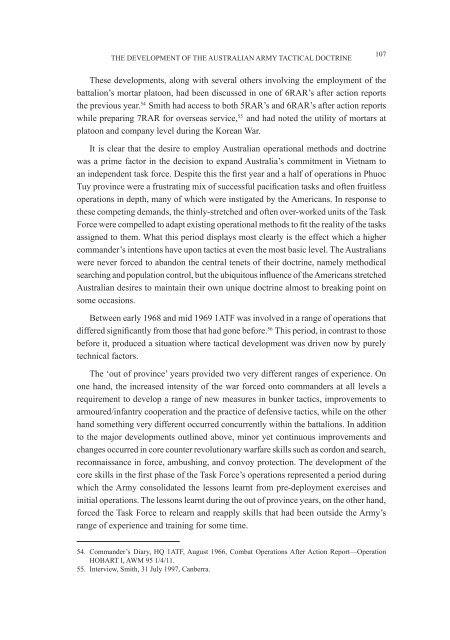conference proceedings - Australian Army
conference proceedings - Australian Army
conference proceedings - Australian Army
You also want an ePaper? Increase the reach of your titles
YUMPU automatically turns print PDFs into web optimized ePapers that Google loves.
THe deVeLoPMeNT oF THe AusTrALIAN ArMy TACTICAL doCTrINe<br />
These developments, along with several others involving the employment of the<br />
battalion’s mortar platoon, had been discussed in one of 6rAr’s after action reports<br />
the previous year. 54 smith had access to both 5rAr’s and 6rAr’s after action reports<br />
while preparing 7rAr for overseas service, 55 and had noted the utility of mortars at<br />
platoon and company level during the Korean War.<br />
It is clear that the desire to employ <strong>Australian</strong> operational methods and doctrine<br />
was a prime factor in the decision to expand Australia’s commitment in Vietnam to<br />
an independent task force. Despite this the first year and a half of operations in Phuoc<br />
Tuy province were a frustrating mix of successful pacification tasks and often fruitless<br />
operations in depth, many of which were instigated by the Americans. In response to<br />
these competing demands, the thinly-stretched and often over-worked units of the Task<br />
Force were compelled to adapt existing operational methods to fit the reality of the tasks<br />
assigned to them. What this period displays most clearly is the effect which a higher<br />
commander’s intentions have upon tactics at even the most basic level. The <strong>Australian</strong>s<br />
were never forced to abandon the central tenets of their doctrine, namely methodical<br />
searching and population control, but the ubiquitous influence of the Americans stretched<br />
<strong>Australian</strong> desires to maintain their own unique doctrine almost to breaking point on<br />
some occasions.<br />
Between early 1968 and mid 1969 1ATF was involved in a range of operations that<br />
differed significantly from those that had gone before. 56 This period, in contrast to those<br />
before it, produced a situation where tactical development was driven now by purely<br />
technical factors.<br />
The ‘out of province’ years provided two very different ranges of experience. on<br />
one hand, the increased intensity of the war forced onto commanders at all levels a<br />
requirement to develop a range of new measures in bunker tactics, improvements to<br />
armoured/infantry cooperation and the practice of defensive tactics, while on the other<br />
hand something very different occurred concurrently within the battalions. In addition<br />
to the major developments outlined above, minor yet continuous improvements and<br />
changes occurred in core counter revolutionary warfare skills such as cordon and search,<br />
reconnaissance in force, ambushing, and convoy protection. The development of the<br />
core skills in the first phase of the Task Force’s operations represented a period during<br />
which the <strong>Army</strong> consolidated the lessons learnt from pre-deployment exercises and<br />
initial operations. The lessons learnt during the out of province years, on the other hand,<br />
forced the Task Force to relearn and reapply skills that had been outside the <strong>Army</strong>’s<br />
range of experience and training for some time.<br />
54. Commander’s diary, HQ 1ATF, August 1966, Combat operations After Action report—operation<br />
HoBArT I, AWM 95 1/4/11.<br />
55. Interview, smith, 31 July 1997, Canberra.<br />
107

















